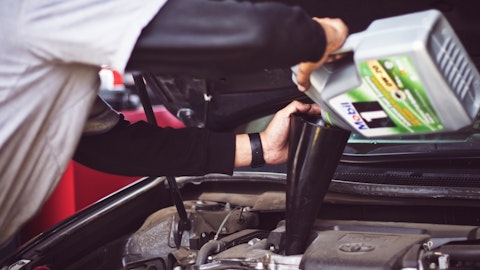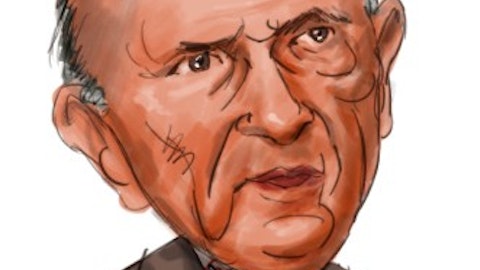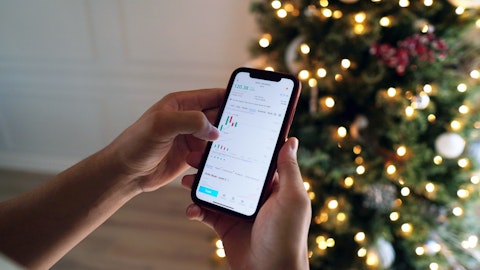AutoZone, Inc. (NYSE:AZO) Q1 2023 Earnings Call Transcript December 6, 2022
Operator: Good morning, ladies and gentlemen, and welcome to AutoZone’s 2023 First Quarter Earnings Release Conference Call. At this time, all participants have been placed on a listen-only mode and the floor will be opened for questions and comments after the presentation. Before we begin, the Company would like to read forward-looking statements.
Brian Campbell: Before we begin, please note that today’s call includes forward-looking statements that are subject to the Safe Harbor provisions of the Private Securities Litigation Reform Act of 1995. Forward-looking statements are not guarantees of future performance. Please refer to this morning’s press release and the Company’s most recent annual report on Form 10-K and other filings with the Securities and Exchange Commission for a discussion of important risks and uncertainties that could cause actual results to differ materially from expectations. Forward-looking statements speak only as of the date made, and the Company undertakes no obligation to update such statements. Today’s call will also include certain non-GAAP measures. A reconciliation of non-GAAP to GAAP financial measures can be found in our press release.
Operator: It is now my pleasure to turn the floor over to Mr. Bill Rhodes, Chairman, President and CEO of AutoZone. Bill, the floor is yours.

Photo by Sara Kurfeß on Unsplashr
Bill Rhodes: Good morning and thank you for joining us today for AutoZone’s 2023 first quarter conference call. With me today are Jamere Jackson, Executive Vice President, Chief Financial Officer; and Brian Campbell, Vice President, Treasurer, Investor Relations and Text. Regarding the first quarter, I hope you have had an opportunity to read our press release and learn about the quarter’s results. If not, the press release along with slides complementing our comments today is available on our website www.autozone.com under the Investor Relations link. Please click on quarterly earnings conference calls to see them. As we begin, we’d like to thank and congratulate our AutoZoners across the enterprise for their commitment to taking care of our customers, which led to the strong results they continue to deliver.
It has been a busy first quarter of our new fiscal year, as every day we strive to get back to normal and exit €˜€˜pandemic mode”. This quarter, we opened our new direct import distribution center on the West Coast, continued to improve our in-stock position, and we had our first full national sales meeting since the pandemic began. In fact, we returned to having national sales meetings in every country where we operate and at ALLDATA. These meetings, they are critical to our success, where we celebrate our past accomplishments and lay the groundwork for our future success. Most importantly, they allow us to inspire each other and grow and nurture our unique and powerful culture. For the quarter, as our teams delivered exceptional service, their efforts led to our overall sales growing 8.6% on top of 16.3% last year.
Our two-year growth rate marks some of the highest ever. We could not have achieved this success without phenomenal contributions from across the organization. Our AutoZoners’ efforts generated a positive and accelerating retail same-store sales comp along with another strong commercial comp for the quarter. Thank you, AutoZoners, for always putting customers first which led to this success. This morning, we will review our Q1 same-store sales, DIY versus the DIFM trends, our sales cadence over the 12-week quarter, merchandise categories that drove our performance and any regional discrepancies. We’ll also share how inflation is affecting our costs and our retails and how we think inflation will impact our business for the remainder of FY23.
Our domestic same-store sales comp was a solid 5.6% this quarter, on top of last year’s 13.6%. On a two-year basis, we delivered a 19.2% comp, and on a three-year basis, a 31.5% stacked comp. Our team once again delivered amazing results, despite these difficult comparisons. Let me spend a few moments on growth dynamics in the quarter. Our growth rates for retail and commercial were both strong with domestic commercial growth of 15%. We set a first quarter commercial sales record and over $1 billion in sales, another impressive quarter as we generated $138 million more in sales than in Q1 last year. On a trailing four quarter basis, we delivered just under $4.4 billion in annual commercial sales, up an amazing $820 million over last year. We also set a Q1 record for average weekly sales per store at $16,000 versus 14,400 just last year.
Domestic commercial sales represented 29% of our domestic auto parts sales versus 27% last year. Our sales growth in the quarter was driven by transaction growth from new and existing customers along with higher tickets as we price for inflation. Our commercial growth of 15%, while still very impressive, and well ahead of industry growth did slow. And unfortunately, we broke our streak of six straight quarters of 20% plus sales growth. While we could easily explain this resulted from a difficult comparison to last year’s Q1 amazing growth of 29.4%, we also saw our transaction counts decline nearly 4 points from the pace we were growing in Q4 of fiscal €˜22. That said, we continue to be pleased with the results from the key initiatives we have been working on for the last several years.
Improved satellite store availability, hub and mega hub openings and improvements in coverage, the strength of the Duralast brand, better technology to make us easier to do business with reduced delivery times, enhancing our sales force effectiveness and living consistent with our pledge by being priced right for the value proposition we deliver. We believe our offering to our customers is better than ever, and we continue to hear great things from our customers and prospective customers about the strength of our value proposition as we continue to execute our commercial acceleration strategy. Our goal remains, over time, to become the industry leader in both, DIY and commercial in every geography where we operate. Our strategy, execution and market momentum give us tremendous confidence as we move forward.
We’re also very proud of our organization’s performance in domestic DIY. Our growth in retail since the beginning of the pandemic has been remarkable, representing the highest three-year growth we have experienced in my 28-year tenure with the Company. We delivered a positive 2.6% comp this quarter on top of last year’s 9%. And versus last year’s — quarter’s growth, DIY grew on a two-year basis and on a three-year basis. While our ticket growth was similar to last quarter, of just over 7%, we are encouraged that our transaction count trends improved, decreasing by 4%. These results are very strong considering the difficult comparison, driven by the lingering effects of stimulus last year. From the data we have available, we continue to retain the vast majority of the enormous dollar share gains we built during the initial stages of the pandemic.
And more importantly, we continue to grow unit share, a critical measurement of success for us. And our recent performance gives us continued conviction about the sustainability for our fiscal year. In terms of sales cadence, our total same-store sales trends were very consistent, increasing in the mid-single-digit range for each of the four-week periods. In addition, for Q1, our two-year comp was 19.2% and our three-year comp was 31.5% and relatively consistent over the four-week periods. We are incredibly pleased with the sustainability of the very large sales and share gains we generated since the beginning of the pandemic. Weather did not have a material impact on our sales this quarter. On a national basis, weather trends were very similar to last year.
Regionally, we saw less rainfall in the West and Southeast than last year. But overall, we didn’t feel this drove our results materially. This winter’s weather forecast calls for a slightly colder winter with, as we’ve recently experienced, cooler weather beginning sooner. As a reminder, historically, extreme weather, cold or hot drives parts failures and accelerated maintenance. During the quarter, there was geographic regions that did better than others as there always are. This quarter, we saw comp sales in the Northeastern and Midwestern markets underperform the balance of the country by about 260 basis points. We believe that our underperformance in these markets was driven by milder and wetter weather this year. Four our second quarter, winter weather is likely to meaningfully influence our results.
As a reminder, our Q2 is historically by far and away the most volatile sales quarter as weather patterns can greatly vary week-to-week. And we have key holidays that fall on different days of the week. At the moment, our forecasting team is telling us winter will likely be colder than last year’s Q2. And if that happens, that would be a positive for our outlook. Now, let’s move into more specifics on our performance. Same-store sales were up 5.6%, our net income was $539 million, and our EPS was $27.45 a share increase$0.45 a share, increasing 6.9%. Regarding our merchandise categories in the retail business, our hard parts outperformed sales floor categories, with approximately 1% difference between them. With elevated gas prices, our discretionary categories remain soft.
The discretionary categories represented approximately 18% of our DIY sales and were down 2.5% versus up 8% last year. In general, the categories that are driven by failures performed well and we were encouraged to see our battery category successfully lap very strong performance last year and again exceed our expectations. We believe our hard parts business will continue to do well this winter as we expect miles driven to improve, while our growth initiatives are delivering solid results. Let me also address inflation and pricing. In Q1, we experienced 11% pricing inflation, in line with cost of goods, which was also up 11%. We believe both numbers will decrease slightly in the current quarter, as we begin to lap the onset of high inflation last year.
But, to be clear, we do not believe inflation is going away, especially wage inflation, but expect it to slow a bit as the economy slows. I want to highlight that our industry has been disciplined about pricing for decades and we expect that to continue. Most of the parts and products we sell in this industry have low price elasticity, because purchases are driven by failure or routine maintenance. Historically, as costs have increased, the industry has increased pricing commensurately to maintain margin rates, thereby increasing margin dollars. It’s also notable that following period’s higher inflation, our industry has historically not meaningfully reduced pricing to reflect lower costs. While we continue to be encouraged with the current sales environment, it still remains challenging for us to forecast near to mid-term sales as the economy impacts our customers.
What I previously said on the past six quarterly calls is sales have been consistent on both a two-year and three-year stack comp basis. While it’s difficult to predict sales going forward, we are excited about our growth initiatives, our team’s execution and the tremendous share gains we have achieved in both sectors. Over the past year and a half, the overall macro environment has been a favorable for our industry despite inflationary pressures for our customers. And even if these near-term trends fade, we believe that we are in an industry that is positioned for solid growth over the long term. For our second quarter of 2023, we expect our sales performance to be led by the continued strength in our commercial business, as we execute on our differentiating initiatives combined with the resilient DIY business.
We will as always be transparent about what we are seeing and provide color on our markets and performance as trends emerge. Before handing the call over to Jamere, I’d like to give a brief update on a few of our key business priorities for the new fiscal year. First, we continue focusing on our supply chain with two initiatives that are in flight to drive improved availability. One is our expanded hub and mega hub rollouts. We know intelligently placing more inventory in local markets will lead to our ability to continue to say yes to our customers more frequently and in turn drive sales. Secondly, we are expanding our distribution center footprint. We announced the development of two new domestic DCs and one additional DC in Mexico. These DCs will allow us to not only reduce drive times to stores, but also increase our capacity.
Note that we didn’t expect to grow our business 30-plus-percent in three years as we have, and the additional capacity will enable us to carry more slower turning inventory that is not yet in high demand. I’m also excited to announce that we opened a facility on the West Coast to handle direct import product on a timelier basis. This facility will flow products ordered abroad and distribute them to our other DCs to reduce safety stock and drive productivity. Our supply chain strategy is focused on carrying more products closer to the customer. And we believe it has been a significant contributor to our recent success, especially in commercial. And we have initiatives in place to continue our growth trajectories in both, our domestic retail and commercial businesses.
Additionally, we plan on continuing to grow our Mexico and Brazilian businesses. At almost 800 stores combined, these businesses have had impressive performance again this quarter and should continue to be key contributors to sales and profit growth for decades to come. We are leveraging many of the learnings we have in the U.S. to refine our offerings in Mexico and Brazil. In Brazil in particular, we are targeting to significantly and aggressively expand our store footprint over the next five years. We are very excited about our growth prospects internationally. Now, I’ll turn the call over to Jamere Jackson. Jamere?
See also Top 10 Hearing Aid Companies and Brands and 22 Most Ethical Companies in the US.
Jamere Jackson: Thanks Bill. Good morning, everyone. As Bill mentioned, from a sales perspective, we had a strong first quarter stacked on top of an exceptionally strong first quarter last year with 5.6% domestic comp growth. We also had a 4.2% decrease in EBIT and a 6.9% increase in EPS. To start this morning, let me take a few minutes to elaborate on the specifics in our P&L for Q1. For the quarter, total sales were just under $4 billion, up 8.6%, reflecting continued strength in our industry and solid execution of our growth initiatives. Let me give a little more color on some of our growth initiatives, starting with our commercial business. For the first quarter, our domestic DIFM sales increased nearly 15% to $1 billion and were up 44.3% on a two-year stack basis.
Sales to our domestic DIFM customers represented 29% of our domestic auto parts sales. Our weekly sales per program were $16,000, up 11.1%. And our growth was broad based as both national and local accounts performed well for the quarter. Our results for the quarter set a record for the highest first quarter weekly sales volume in the history of the chain. I want to reiterate that our execution on our commercial acceleration initiatives continues to deliver exceptionally strong results as we grow share by winning new business and increasing our share of wallet with existing customers. We have a commercial program and approximately 88% of our domestic stores, which leverages our DIY infrastructure. And we’re building our business with national, regional and local accounts.
This quarter, we opened 117 net new programs finishing with 5,459 total programs. As I have said previously, commercial growth will lead the way in FY23. And we continue to deliver on our goal of becoming a faster growing business. Our strategy and execution continue to drive share gains and position us well in the marketplace. Delivering quality parts, particularly with our Duralast brand, improved assortments and local market availability, competitive pricing and providing exceptional service has enabled us to drive double-digit sales growth for the past nine quarters. In addition, we are increasing the penetration of our market leading ALLDATA shop management, diagnostic and repair software suite to new and existing commercial customers, which gives us yet another key competitive advantage.
And as I’ve noted on past calls, our mega hub strategy is driving strong performance and position us for an even brighter future in our commercial and retail businesses. Let me add a little more color on our progress. As we’ve discussed over the last several quarters, our mega hub strategy has given us tremendous momentum. We now have 80 mega hub locations with two new ones open in Q1. While I mentioned a moment ago, the commercial weekly sales per program average was $16,000, the 80 mega hubs averaged significantly higher sales and are growing much faster than the balance of the commercial footprint. As a reminder, our mega hubs typically carry 80,000 to 110,000 SKUs and drive tremendous sales lift inside the store box as well as surge as an expanded assortment source for other stores.
The expansion of coverage and parts availability continues to deliver a meaningful sales lift to both, our commercial and DIY business. What we’re learning is that not only are these assets performing well individually, but the fulfillment capability for the surrounding AutoZone stores gives our customers access to thousands of additional parts and list the entire network. This strategy is working. And we remain committed to our objective to reach 200 mega hubs supplemented by 300 regular hubs. We’re targeting at least 25 new mega hubs in FY23. We continue to leverage sophisticated data analytics to expand our market reach, placing more parts closer to our customers, and improving our delivery times. We’re determined to build on our strong momentum.
Our domestic retail business count was 2.6% in Q1. The business has been remarkably resilient as growth rates accelerated from Q4 and we have managed to continue to deliver positive comp growth despite underlying market headwinds. As Bill mentioned, we saw traffic down 4% from last year’s levels. However, they improved sequentially from Q4, where traffic was down 7%. We also saw 7% ticket growth as we continue to raise prices in an inflationary environment. Our DIY businesses continue to strengthen competitively behind our growth initiatives. In addition, on a macro basis, the market is experiencing a growing and ageing car part and is still challenging, new and used car sales market for our customers. These dynamics, pricing, growth initiatives and macro car part tailwinds have driven a positive comp despite tough comparisons from last year’s stimulus injection, and consumer discretionary spending pressure from overall inflation in the economy.
Our sales were steady through the quarter, and we’re forecasting a resilient DIY business in FY23. Now, I’ll say a few words regarding our international businesses. We continue to be pleased with the progress we’re making in Mexico and Brazil. During the quarter, we opened three new stores in Mexico to finish with 706 stores and 4 new stores in Brazil ending with 76. On a constant currency basis, we saw accelerated sales growth in both countries, in fact at higher growth rates than we saw overall. We remain committed to our store opening schedules in both markets and expect both countries to be significant contributors to sales and earnings growth in the future. With 11% of our total store base currently outside the U.S. and a commitment to continue expansion in a disciplined way, international growth will be an attractive and meaningful contributor to AutoZone’s future growth.
As Bill mentioned earlier, we expect significant growth in store count internationally over the next five years. And we’re excited about the future. In the spirit of our growth in store count outside of the U.S. we will celebrate our chain’s 7,000th store opening this week in Leon, Mexico. I know Bill looks forward to being there to celebrate this historic event with our AutoZoners. We couldn’t be more proud to celebrate this occasion with our Mexico team. Now, let me spend a few minutes on the rest of the P&L and gross margins. For the quarter, our gross margin was down 242 basis points, driven primarily by a 203 basis-point headwind, stemming from a noncash $81 million LIFO charge. The difference for the quarter, a decline of 39 basis points in gross margin was primarily driven by our faster-growing lower gross margin commercial business.
With this quarter’s LIFO charge, we have taken our LIFO credit balance to $96 million. As I mentioned last quarter, hyperinflation and freight costs are the primary driver for the charges. We are still modeling for higher freight costs through the end of the calendar year, and we anticipate approximately $40 million in LIFO charges during the second quarter. Both the first quarter actuals and our second quarter outlook are below the outlook we gave last quarter, as freight costs have continued to abate over the past few months. As spot rates have come down, we have also renegotiated some of our long-term contracts and the lower costs are reflected in our outlook. We expect freight costs to continue to abate, and I want to remind everyone that at some point we expect to see these quarterly charges reverse, and we will begin to rebuild our LIFO reserve balance.
We plan to take P&L gains only to the extent of the charges we have taken thus far, and after we have taken P&L gains that fully reverse the charges we have incurred, we expect to rebuild our LIFO reserve balances we have done historically. Moving on to operating expenses. Our expenses were up 8.6% versus last year’s Q1 as SG&A as a percentage of sales were flat with last year. Our operating expense growth has been purposeful, as we continue to invest at an accelerated pace in IT and payroll to underpin our growth initiatives. These investments are expected to pay dividends in customer experience, speed and productivity. We are committed to being disciplined on SG&A growth as we move forward, and we will manage expenses in line with sales growth over time.
Moving to the rest of the P&L, EBIT for the quarter was $723 million, down 4.2% versus the prior year’s quarter. Excluding the $81 million LIFO charge, EBIT would have been up 6.6% over last year’s quarter. Interest expense for the quarter was $57.7 million, up 33.4% from Q1 a year ago as our debt outstanding at the end of the quarter was $6.3 billion versus $5.3 billion at Q1 in last year, and our variable rates have increased significantly. We are planning interest in the $60 million range for the second quarter of fiscal 2023 versus $42.5 million in last year’s second quarter. Higher debt levels and expected higher borrowing costs across the curve are driving this increase. For the quarter, our tax rate was 18.9% and below last year’s first quarter rate of 21.9%.
This quarter’s rate benefited 446 basis points from stock options exercised, while last year benefited 159 basis points. For the second quarter of FY 2023, we suggest investors model us at approximately 23.4% before any assumption on credits due to stock option exercises. Moving to net income and EPS. Net income for the quarter was $539 million, down 2.9% versus last year’s first quarter. Our diluted share count of 19.6 million was 9.1% lower than last year’s first quarter. The combination of lower net income, offset by lower share count drove earnings per share for the quarter to $27.45, up 6.9% over the prior year’s first quarter. Excluding the LIFO charge, our net income would have increased 8.3% and our EPS growth would have been 19.2%.
Now, let me talk about our free cash flow for Q1. For the fourth quarter, we generated $794 million of operating cash flow, and spent $114 million in CapEx, allowing us to generate $680 million in free cash flow versus $676 million a year ago. We expect to continue being an incredibly strong cash flow generator going forward, and we remain committed to returning meaningful amounts of cash to our shareholders. Regarding our balance sheet, our liquidity position remains very strong and our leverage ratios remain below our historic norms. Our inventory per store was up 14.4% versus Q1 last year, and total inventory increased 17.6% over the same period last year, driven primarily by inflation, our growth initiatives and in-stock recoveries. Net inventory defined as merchandise inventories less accounts payable on a per store basis was a negative $249,000 versus negative $207,000 last year, and negative $240,000 last quarter.
As a result, accounts payable as a percent of gross inventory finished the quarter at 131% versus last year’s Q1 of 129.4%. Lastly, I’ll spend a moment on capital allocation and our share repurchase program. We repurchased $900 million of AutoZone stock in the quarter and at quarter end, we had just under $2.7 billion remaining under our share buyback authorization. The strong earnings, balance sheet and powerful free cash we generated this year has allowed us to buyback almost 2% of the shares outstanding at the start of the fiscal year. We have bought back well over 90% of the shares outstanding of our stock since our buyback inception in 1998, while investing in our existing assets and growing our business. We remain committed to this disciplined capital allocation approach that will enable us to invest in the business and return meaningful amounts of cash to shareholders.
We finished Q1 at 2.2 times EBITDAR, which is below our historical objective of 2.5 times. However, we remain committed to this objective, and we expect to return to the 2.5 times target during FY23. To wrap up, we remain committed to driving long-term shareholder value by investing in our growth initiatives, driving robust earnings and cash and returning excess cash to our shareholders. Our strategy continues to work. We’re growing our market share and improving our competitive positioning in a disciplined way. And as we look forward to FY23, we’re bullish on our growth prospects behind a resilient DIY business and fast growing commercial and international businesses that are growing considerable share. I continue to have tremendous confidence in our industry, our business, and the opportunity to drive long-term shareholder value.
Before I turn it back to Bill, on December 5th, we celebrated Bill’s 28th year anniversary with the Company. And I want to say congratulations to you, Bill. And it’s been a remarkable ride.
Bill Rhodes : Thanks, Jamere. Fiscal 2023 is off to a solid start. But we must continue to be focused on superior customer service and flawless execution. Execution and our culture, a culture of always putting the customer first is what defines us. As Jamere said a moment ago, we continue to be bullish on our industry and in particular on our own opportunities for the New Year. Our team continues to work collaboratively with our suppliers. And together, we’ve done a good job improving our in-stock position. But we still are a couple of hundred basis points below our historical norms. We’re also being smart about adding new inventory coverage. We’re meeting the ever-growing needs of our customers, especially our commercial customers, by being able to say, yes, we’ve got it.
It’s a requirement. For the remainder of fiscal €˜23, we are launching some very exciting initiatives. Not only will we be opening roughly 200 stores across the U.S., Mexico and Brazil, but we’ll be opening more mega hubs and hub stores. And we’re focused on initiatives in place to continue driving strong performance in both, our retail and commercial businesses. For the remainder of fiscal 2023, we are keenly focused on relentless execution. We will not accept shortcuts. Our vendors must return to providing us the right amount of merchandise at the right time. Every store has to be staffed right, every hour of every day, and our processes need to function correctly, always. We have to meet our store opening goals and timelines. Simply put, we have to focus on exceptional execution.
It has made a difference for us for decades. We know that investors will ultimately measure us by what our future cash flows look like three to five years from now, and we very much welcome that challenge. I continue to be bullish on our industry and in particular on AutoZone. Now, we’d like to open up the call for questions.
Q&A Session
Follow Autozone Inc (NYSE:AZO)
Follow Autozone Inc (NYSE:AZO)
Operator: And the first question this morning is coming from Brian Nagel from Oppenheimer. Brian, your line is live. Please go ahead.
Brian Nagel: Hi. Good morning. Nice quarter. So, the first question I have, just with respect to freight costs, and Jamere you talked about this in your comments, and you mentioned the LIFO issues. But I guess the question I have is as we think about your freight costs now and what you’re seeing, where are you now tracking say, versus pre-pandemic? And then, even maybe putting some of the accounting noise aside, at what point could this become a tailwind to gross margins, as it really starts to work through the P&L?
Jamere Jackson: Yes. Thanks, Brian. International freight rates are back at pre-pandemic levels. And one of the things that we discussed on last quarter’s call was this notion that during the height of the pandemic to secure capacity, we entered into some longer-term contracts. We’re now in a position where as the spot rates have come down, we’ve renegotiated some of those contracts. We have a pretty bullish outlook on where international freight rates are going to be for the balance of the year. Domestically, rates are still a little bit high. And as we work our way through the year, we expect those to start to abate a little bit. But domestically, the rates are still a little bit higher than what we would have anticipated.
As it relates to LIFO, as you saw in the second quarter, we have lowered our outlook to be about a $40 million charge. And you could see in the back half of the year that abating completely. I won’t be date certain about when we’ll see this flip to gains rolling back through the P&L. But as we said last quarter, it could take the equivalent of three or four quarters before it all rolls through. And we see the gains come back through the P&L that offset the charges that we’ve taken. So, our outlook is positive, and we’re managing the business accordingly.
Bill Rhodes: Can I jump in and add a little color on one other element, not on LIFO, but on our normal product cost? Many of those freight costs are being capitalized as part of the inventory cost. So, we’re going to have elevated product cost outside of LIFO for — in a business that’s turning 1.5 times a year for 9 months or a year, whatever the case may be, once those freight costs abate. So, we’ll continue to have pressure on product cost for foreseeable — for an extended period of time.
Brian Nagel: That’s very helpful. I appreciate the color there. And then as a quick follow-up, with respect to traffic, and also going back to the comments you made, so it’s — I think what you said was that the traffic in the stores, while still down in Q1, had improved from Q4, any comments on maybe the trajectory through the quarter? And then how are you thinking about traffic as we move into — continue to progress through €˜23 here?
Bill Rhodes: Yes, Brian. So, when we’re talking about traffic, we’re predominantly talking about — we are talking about our DIY business. I will be first to tell you that our DIY strength in Q1 was stronger than we expected, considerably stronger than we expected. And yes, our traffic counts are down 4%, but that was meaningfully better than — I believe it was 8% in Q4. Remember — and you’ve been following this industry for a long time, there is a natural drag on DIY traffic counts that have been happening for 25 years. As you know, technology has gotten better and better on the products that we sell, and so they last longer. But there’s also inherent inflation in those product costs as technologies are added to the products. So, a 4% traffic decline in the DIY business is not abnormal in normal times. And to see it down 4% after the growth that we’ve seen over the last three years was very encouraging to us.
Operator: Your next question is coming from Simeon Gutman from Morgan Stanley.
Simeon Gutman: Good morning, everyone, and Bill, congratulations on the anniversary. My question is actually a follow-up to what you just mentioned, Bill. The traffic or I guess we will look at — we try to call it units, I don’t know if you would say that they’re synonymous. It did look like it improved sequentially on a single-year basis. We don’t see what the stacks have looked like, I think, on traffic or units. And curious if underlying stacks are also improving such that this is the rebasing and we are in the all clear in terms of units probably done reverting and the negative numbers are normalizing back to that negative 4% that you mentioned.





